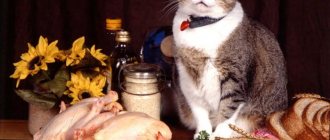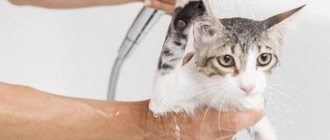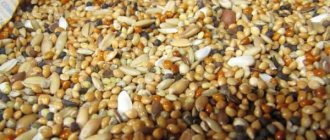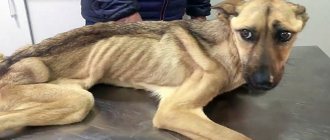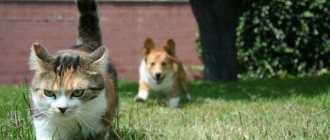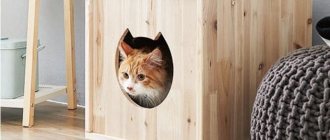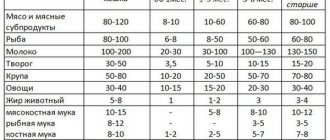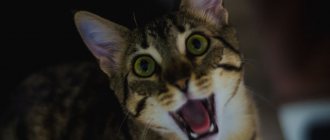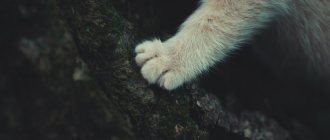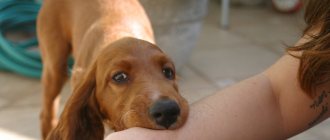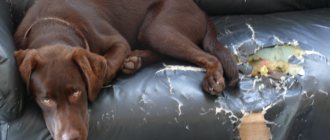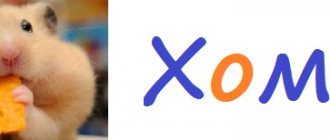Regardless of how thin or obese the cat is, this will in any case negatively affect its health. Regardless of the condition, the animal develops a phalanx of certain pathologies. If you are faced with the fact that your cat has lost a lot of weight, we will tell you what to do in this case.
Normal weight and causes of exhaustion
The average weight of an adult cat varies from 3 to 6 kg. This indicator depends on:
- Way of life.
- Genetic factors.
- Type and quality of food.
- Age and health status.
- Gender and breed.
Healthy pet A veterinarian will help determine the ideal weight for a particular cat. In addition, in order to monitor your pet’s health, it must be shown to a doctor once every six months.
| Breed | Small | Average | Large | ||||||
| normal | full | thick | normal | full | thick | normal | full | thick | |
| Abyssinian | 3.4 | 3.7 | 4.3 | 4.3 | 4.7 | 5.1 | 5.1 | 5.6 | 6.1 |
| British Shorthair | 3.7 | 4.2 | 4.8 | 4.8 | 5.3 | 5.7 | 5.8 | 6.5 | 6.9 |
| Scottish lop-eared | 4.0 | 4.5 | 4.8 | 5.0 | 5.5 | 6.0 | 6.0 | 6.6 | 7.2 |
| Sphinx | 3.4 | 3.7 | 4.1 | 4.3 | 4.7 | 5.1 | 5.1 | 5.6 | 6.1 |
| Persian | 3.8 | 4.2 | 4.6 | 4.8 | 5.2 | 5.7 | 5.7 | 6.3 | 6.8 |
| Maine Coon | 5.8 | 6.4 | 7.0 | 7.3 | 8.0 | 8.8 | 8.8 | 9.6 | 10.5 |
| Munchkin | 3.0 | 3.6 | 4.0 | 4.1 | 4.5 | 4.9 | 5.0 | 5.3 | 5.8 |
If the cat does not reach the lower limit of weight (based on the table above), this indicates exhaustion of the body. The reason may be:
- Forced starvation (if the animal was lost and lived on the street for a long time).
- Stress (for example, a change of place of residence or the arrival of new people in the family).
- Lack of appetite (results from a number of diseases).
- Dysphagia (eating disorders, inability to swallow food, caused by diseases or injuries of the esophagus, foreign objects entering the esophagus).
- Regurgitation or vomiting (results from a number of diseases).
- Metabolic disease.
- Diseases of the urinary system.
- Increased energy consumption due to high activity.
Wasting Wasting can be considered an animal losing more than 10% of its initial body weight. The causes of this condition may be different, in any case, the cat needs care and treatment prescribed by a veterinarian. In such situations, it is better not to self-medicate.
How to fatten a natural-fed cat
If the cat is on a natural diet, then the diet should be based on foods rich in protein and fats. It can be not only meat, but also fish and poultry. However, you should not overuse varieties that are too fatty.
Cereals should be added to meat products, except rice and pearl barley. We must not forget that cats need fermented milk products, as well as vegetables. To avoid rejection of the latter, they must be mixed into minced meat.
Table: natural food for adult cats and kittens (daily value in grams)
| Feed | Adult cats | Kittens | |||
| Up to 1 month | 1–3 months | 3–6 months | From 6 months and older | ||
| Meat | 80–120 | From 8 to 10 | From 10 to 60 | From 60 to 80 | From 80 to 100 |
| Fish | 80–100 | From 6 to 8 | From 8 to 50 | From 50 to 60 | From 60 to 80 |
| Milk | 100–200 | From 20 to 30 | From 30 to 100 | From 100 to 130 | From 130 to 150 |
| Cottage cheese | 30–50 | 3,5 | From 5 to 10 | From 10 to 15 | From 15 to 20 |
| Groats | 50–80 | From 10 to 20 | From 20 to 50 | From 50 to 70 | From 70 to 80 |
| Vegetables | 30–40 | From 10 to 15 | From 15 to 20 | From 20 to 30 | From 30 to 40 |
| Animal fat | 5–8 | 1 | From 1 to 2 | 3 | From 3 to 4 |
| Meat and bone meal Fish meal Bone meal | 10–15 8–12 8–10 | — — 1–2 | 5–8 — 2–5 | 8–10 3–5 5–7 | 10–12 3–5 7–8 |
| Fish fat | 1,3 | 0,5 | 0,5–1 | ||
| Chicken eggs (boiled) | 1–2 pcs. in Week | ||||
To create the correct diet from these products, you need to consult a veterinarian. This will prevent mistakes and quickly restore the animal’s weight.
If the owner feeds the cat natural food, then he needs to know which foods are prohibited for the animal:
- raw chicken eggs;
- tuna, especially canned;
- grapes (fresh and in the form of raisins);
- baked goods made with yeast dough.
Anorexia
The disease can be called an extreme degree of exhaustion only conditionally.
Anorexia is characterized by severe thinness due to a dulled feeling of hunger. And if in humans the reasons are obvious, then in cats everything is not so simple. Let's list some of them:
- Chemotherapy course. Treatment of malignant tumors is often accompanied by a host of side effects. One of them is a radical refusal to eat. The cat loses interest in food, refuses to play, prefers to hide in secluded places and sleeps a lot.
- Consequences of a major operation . Medicines, including anesthesia, greatly affect the pet’s mood and its orientation in space. They can have a detrimental effect not only on taste preferences, but also completely deprive them of interest in food. Even months later, your cat may still feel the effects of a major surgery.
- Failure of the senses. Usually associated with traumatic brain injuries. This leads to disturbances in neural communication, loss of taste or smell. The cat simply does not understand what is edible and what is not. She can experiment, but in most cases she will get a negative experience. All this leads to the described illness.
Anorexia is very different from simple weight loss. In this case, simple fattening is not enough. In any case, you should contact a veterinarian, get tested and undergo a course of treatment.
The main mistakes when planning your diet
I would also like to touch upon the topic of mistakes in feeding pets, made by owners with the best intentions. Despite the fact that each owner chooses his own intuitive diet plan for his pets, one can notice repeated and very sad “rake”, which people regularly continue advance.
Some cat owners believe that the doses of dry food indicated on the packaging are too small for their cats; some overfeed their pets with all types of meat, being confident in its clear benefits.
Sometimes an abundance of healthy food can cause various ailments
Complications with digestion or hair that arise later in an animal sometimes cause genuine surprise among the owners and a lack of understanding of their role in the resulting illness. We’ll talk about how to recognize your mistakes in planning your cat’s nutrition and stop them in time.
Common mistakes in feeding cats
What to feed to gain weight?
There are feeds for increasing the weight of animals, called medicinal, but they are more expensive than usual. However, if the pet is in critical condition and does not digest natural food well, this is the only feeding option.
If the weight loss is insignificant, you can fatten your pet with natural products. Weight gain is achieved by intelligently replacing proteins with carbohydrates. It is better to avoid fatty foods (or reduce them to a minimum); strive to gain muscle mass, not fat.
From hand
What can you feed your cat to make him fat?
- Meat : rabbit, chicken should be in the diet daily (60-75% of the total diet). To eliminate the risk of infection with worms, the meat must be deep frozen (sometimes it can be boiled) before consumption.
- Fish : ocean only. Make sure that there are no bones in the fish, as they contribute to the development of diseases of the urinary organs.
- Eggs (white and yolk): boiled and raw. Use no more than 2 times a week, 1 pc.
- Dairy products : cottage cheese, sour cream, unsweetened yogurt. It can be introduced into the diet gradually; it is better not to use store-bought products.
- Milk should be completely excluded from the diet of a domestic cat, as it puts a lot of stress on the liver and is poorly digested.
- Hard cheese . Useful in small doses; if overused, it can overload the liver.
- Cereals : rice, buckwheat, millet, etc. 1 teaspoon for each meal.
- Fruits . If the cat doesn’t mind, then you can, but you shouldn’t force feed it.
- Greens : parsley, dill, lettuce. Greens help improve digestion, so it is useful to add them to every meal.
- Oils : sunflower, flaxseed, olive. Only as a supplement.
Your task is to formulate your cat’s daily routine so that the body has to spend as little energy as possible. Reaching the golden mean is difficult, especially if the pet is overly active and picky about food.
Attention! Avoid sausages, canned meat and fish; such products contain a lot of salt and spices. They can harm the cat's digestive system.
Nutrition needs to be reviewed
To speed up the weight gain process, use vitamin supplements. They activate metabolism, which will force the body to digest and absorb food faster. It is important to consult your veterinarian before using vitamins.
When a cat needs feeding
Before you start fattening a cat, you need to understand the reasons that prompted the owner to make such a decision. If cats are not sick or hungry, they are able to independently control their weight and the amount of food they consume.
Not all cats need an increase in diet
Among the good reasons why a cat owner can begin to purposefully feed him are the following:
- Gaining normal weight after a debilitating illness.
The most common cause of weight loss in cats is all kinds of parasites that literally suck all the vitality out of the cat. Other pathologies that negatively affect an animal’s weight include gastritis, ulcers, and other digestive disorders. Such an innocent thing as dysbiosis in its neglected form leads to frequent vomiting, and – as a result – rapid weight loss. All of these conditions are abnormal for a cat and require a balanced diet for weight gain; Recovery from illness takes a lot of resources from the body and takes time. - Restoring selected cats to home conditions.
Stray animals cannot boast of a proper diet and intake of all important vitamins and minerals. Such individuals end up in their owners’ homes with varying degrees of neglect. The owner’s tasks include showing the kitten (or adult cat) to the veterinarian, examination, vaccination and development of further diet; At home, previously homeless cats do not immediately get used to the abundance of food. - Fitting the cat to show standards.
This item applies to that small group of owners who demonstrate their purebred individuals at exhibitions. Since each breed has its own requirements in detail, deviations from the specified weight are unacceptable. However, if this deviation occurs, then the owner should think about its reasons before starting fattening. Typically, purebred cats correspond to the weight stated in the standards with minor deviations. If careful feeding is required for the exhibition, then this is a reason to show the pet to the veterinarian; Exhibition animals are subject to strict weight requirements. - Recovery of a cat after prolonged stress.
This situation is quite rare, but it happens that pets are taken from specific owners who monitored the health of their cats, but treated them inappropriately. Unfortunately, sadism against animals still occurs today. Prolonged negative experiences and depression can lead to a complete loss of appetite and poor digestion of food, which the new owner must gradually rid his pet of; Many cats lose their appetite when faced with intense negative experiences. - Depletion of the body of an elderly cat.
Cats that are over ten years old are not often seen as fat or even well-fed. Despite the gradual slowdown of metabolism and a general decrease in activity, the bodies of older animals lose body weight. This happens for various reasons, for example, tooth decay and the inability to chew food without accompanying pain. The diet of aging individuals, as well as the diet of kittens, must be carefully monitored, since any wrong movement can end badly for the fragile health of the pet. Aging cats are more sensitive to low-quality or too strong food
How to identify excessive thinness in a pet
Due to the large number of breeds, many cats have significant differences in appearance. This is why some people may mistake a slender and lean animal for an emaciated one. You need to know the difference between physiological and pathological thinness.
Signs of a healthy cat with a slender physique:
- the proportions between the sizes of the head, torso and limbs are observed;
- ribs and vertebrae are not visible through the layer of wool, but are easily found when palpated;
- the waist is pronounced;
- there is a thin layer of fat in the chest and abdomen area;
- the animal is active, plays a lot and eats with appetite;
- The coat is smooth, shiny, easy to comb and does not fall out.
Oriental breed cats have well-developed muscle mass and a small layer of fat
With pathological thinness, the following signs are observed:
- protruding shoulder blades, ribs, hip bones are visible to the naked eye;
- the head and ears are sharply enlarged compared to the body, the limbs are thin;
- the muscles are poorly developed, fatty tissue on the abdomen and back cannot be felt;
- the fur falls out in uneven tufts, there may be tangles;
- the animal spends a lot of time sleeping, moves little, and changes in appetite are observed (ravenous hunger or complete lack of desire to eat).
When a cat is emaciated, bones can be seen through the skin.
The dangers of excessive fattening
For those owners who want to fatten their pet for their own aesthetic needs - to admire how funny the cat licks or runs - it is useful to learn about the consequences of feline obesity. Since obesity in cats, like in humans, is a disease, a fat cat will sooner or later face health problems, including:
- Diabetes of the second type - being initially not prone to diabetes, your pet can develop it with an incorrect lifestyle and, in particular, nutrition.
As a result, the owner will have to periodically inject insulin into the cat in order to avoid a sharp deterioration in his health; Diabetes is one of the most dangerous consequences of overfeeding a cat. - Cardiovascular diseases - the higher the weight of the animal, the greater the load on the heart.
Overweight cats, as a rule, rarely move and prefer a recumbent lifestyle, which only aggravates the situation; Gaining excess weight is fraught with heart attacks leading to heart attack - High probability of joint injury - any long-distance jumps can result in dislocations, or, in the worst case, fractures.
Since the bones and joints of each cat are tailored to a certain body weight, which has its own threshold, going beyond its limits is fraught with all sorts of injuries; Overweight cats have a more difficult time recovering from fractures due to the heavy load on the joints. - Predisposition to arthritis.
Fat animals are the first at risk in terms of the likelihood of becoming acquainted with this unpleasant disease, accompanied by inflammation of joint tissues and deformation of the limbs, not to mention purulent complications; In advanced cases, arthritis can only be treated with a surgical scalpel - Hypertension - this disease is difficult to diagnose in the initial stages, but its harm to the entire body is very great. In its chronic form, hypertension leads to hypertrophy of the heart muscle, which, with the least favorable prognosis, ends in cardiac arrest.
Keep in mind that a deviation of one and a half kilograms from the norm is already considered obesity and unsafe for the pet’s health. Since pets differ significantly from us in size, they only need to gain a few hundred grams for this to become noticeable. You can read about the process of losing weight in cats on our portal.
Recipe No. 2
Fresh meat for lunch:
- Chicken breast - 100 g.
- Lean pork meat (can be replaced) - 30 g.
- Rice - 1 tbsp. spoon.
- Chopped parsley - a handful.
- Vegetable oil - 1 teaspoon.
Chop the meat with a knife and mix with the rest of the ingredients. Store for no more than 2 days.
Fresh meat for lunch
What age can be considered correct to buy a kitten?
A small one-month or two-month-old kitten looks funny and very cute. Those who want to get a furry friend think that a kitten at three or four months is already too big, will not be able to quickly get used to a new place, and will play less. The buyer, fascinated by the cute face, does not think about the fact that he will have to replace the kitten’s mother and teach him to eat, use a tray and scratching post, wean him from gnawing wires, biting, scratching and many other important things
And it doesn’t matter whether he’s purebred..
Discussion
Everything is correct) We have reserved our kitty, we will pick it up at 4 months) In the meantime, she hangs out with her sisters, mommy, learns good manners, she gets her first vaccinations and sends us reports and photos)
Our cat came to us at 4.5 months. I managed to see enough of the childish expression and funny behavior. Got used to it instantly.
Why does my cat need to lose weight?
A single kilogram of excess weight already increases the risk of your pet developing serious diseases. Unfortunately, if your cat is overweight or obese, it is no longer a question of whether she will develop complications and illnesses associated with it, but when exactly they will appear and how serious they will be. Most often, excess weight is accompanied by:
- Type II diabetes – it is three times more common in obese cats than in animals of normal weight;
- Heart diseases;
- Increased risk of joint injuries;
- Osteoarthrosis (arthritis);
- High pressure;
- Some forms of cancer, especially tumors in the abdominal cavity.
Overweight and obese animals tend to live shorter lives than their slender counterparts. If a cat is overweight, it moves less and becomes less energetic and playful. The purr prefers to just lie down, and because of this it is easy to miss the first signs of illness, mistaking lethargy for “normal laziness.”
Now we are just beginning to understand the danger that extra pounds can pose to both humans and their four-legged friends.
Feeding rules
You need to feed a kitten to gain weight taking into account general recommendations and rules. Among the foods that will contribute to moderate obesity in your pet, it is worth highlighting the following:
- lean meat. This product should make up the lion's share of the diet;
- carbohydrates. It is recommended to feed your cat cereals. Nevertheless, it is better to immediately remove rice and pearl barley from the daily menu; sea fish. Give preference to low-fat varieties;
- dairy products. In order to stimulate digestive processes, you should definitely worry about feeding your cat kefir, cottage cheese, and sour cream.
If you want to fatten up your cat as quickly as possible, but do not want to bother with creating a menu of homemade products and constantly purchasing them, there is an alternative option - industrial food. If you buy a premium composition, you will provide your pet not only with ingredients that are important for him, but also with various vitamin supplements. Such mixtures are distinguished by a balanced composition, which will solve all nutrition problems.
Interestingly, some modern manufacturers produce cat food specifically for malnourished animals. They contain large quantities of mineral supplements and vitamin complexes that quickly normalize your pet’s health. As a result, he will begin to gain weight actively.
Recipe No. 5
Milk breakfast:
- Powdered milk - 1 tbsp. spoon.
- Chicken eggs - 2 pcs.
- Cottage cheese - 3 tbsp. spoons.
- Chopped vegetables - 2 tbsp. spoons.
Add a few tablespoons of cold water to the milk powder, then beat in the eggs and bring the mixture until smooth. Gradually stir in cottage cheese and vegetables. Pour the mixture into the pan and cook for 2 minutes on each side. Cool, cut and serve to your pet.
Milk breakfast
Attention! Remember, no salt or spices should be used in any recipe. They will irritate the animal’s receptors, which will negatively affect its sense of smell and perception of taste.
Choosing a kitten in 10 steps. Blog of user Mira88 on 7ya.ru
So, you have decided to get serious about buying a purebred kitten and want to know how this should happen.
Below I will give a few key points that must be taken into account so that the purchase does not cause disappointment. Choose and buy a kitten personally. The kitten should be chosen by the future owner himself, or by the owners if the family consists of several people. Remember that you choose not only a kitten, but also a breeder with whom you will have to communicate after the purchase for advice. Before... Discussion
Today there is still a lot of pain that animals endure, so to speak, and you know in such a situation it is still quite important to choose the same kitten with a full package of documents. Yes, I agree with you that this way you will have to spend more money than even buying a kitten from the market, but at the same time you will be sure that the cat is healthy
In addition, when I adopted the kitten three months ago, even though I had documents, I took the kitten for examination to a doctor.
Sources of fats
This element must be included in a cat’s natural diet, since it is not only, along with carbohydrates, a source of energy, but also supplies the body with many vitamins:
- A - improves vision, is responsible for the condition of the skin and coat;
- D - is of great importance for the formation of the skeleton;
- E - strengthens muscles, regulates the normal functioning of the genitourinary system;
- K - is an important element for strengthening joints and bones, and the functioning of the cardiovascular system.
In addition, fats give food an attractive taste and smell, promote intensive growth and harmonious development of the animal. Their share in the pet’s diet with natural nutrition should be at least 20%.
If it is not possible to provide the animal with food with a sufficient amount of these components, then fish oil can be added to it.
Supplements and vitamins – are they necessary?
The need to add vitamins depends on the type of diet. With dry feeding, all the necessary substances are already present in the composition, so additional elements can cause a surplus.
The opposite situation is typical for natural feeding. In this case, vitamins simply must be present in the diet. But even here you can provoke their excess by trusting the advice of friends. It is better to clarify this question with a veterinarian, who will select a ready-made complex for your pet based on the test results.
Mistakes and dangers
A common belief is that cats will not eat anything that can harm them. In fact, this is not so; pets often eat food that is not healthy and even harmful to them. Most often this happens because their owners make the following mistakes:
- They feed from the table. Pets often ask to share human food, and not all owners can resist. Remember, your food contains a large amount of salt and spices, which are harmful to the digestion of animals.
- Mix types of food. Decide on your pet’s type of food: natural or industrial food. Both methods have their advantages and disadvantages, but combining them leads to indigestion.
- They ignore daily norms. It is easy to feed a cat to be fat, since this simply requires giving him an unlimited amount of food every day. If you do not pursue such a goal, it is better to stick to the daily intake (discuss with your veterinarian).
- They switch abruptly from one type of food to another (from natural to dry food). The change in feeding method must be smooth, otherwise the pet will develop vomiting or diarrhea.
Recommendations from experts
When fattening an animal, it is especially important not to harm it. Therefore, you should listen to the recommendations of experts:
- Do not mix different brands of food. This leads to an imbalance of elements, which will have a negative impact on the pet’s health.
- It is better to avoid food that can be easily purchased in any supermarket (for example, Whiskas, Kitiket). Such economy-class feeds lead to diseases of the genitourinary system, the formation of kidney stones, pancreatitis and other pathologies.
- Cats are clean and groom themselves constantly. Accordingly, wool enters the digestive system. This can cause problems in weakened animals. To help pets, they need to be given Maltpaste. It helps naturally remove hairballs from the digestive tract.
Maltpaste is designed to remove hairballs from the digestive tract of cats.
What feed is best to use?
If the cat is very thin and emaciated, then a veterinarian will help you choose the right diet. Most often, experts recommend using ready-made dietary products that are sold in pet pharmacies.
The most popular brands are:
- Hill's a/d;
- Royal Canin Recovery;
Royal Canin Recovery food is well suited for cats that are weak or sick, it is easily digestible and gives the animal a lot of energy.
- ProPlan Convalescence.
All these diet foods are produced in the form of soft food - pates. This form was not chosen by chance. Soft food is easier to digest, and this is what a depleted body needs. The gastrointestinal tract will not be overloaded and the cat will not spend extra energy on digestion. If the cat is exhausted to such an extent that she can no longer eat on her own, then this kind of nutrition can be easily administered through a tube.
The food is distinguished by a high content of elements such as fat and proteins, vitamins and minerals. Thanks to this composition, the body recovers faster.
Wet food is also used for emaciated kittens. This diet is high in calories and also contains more vitamins necessary not only for recovery, but also for growth.
It is better not to use dry food during this period. They belong to tough and solid foods. Depending on the reasons for weight loss, not every cat will be able to easily digest such food.
Dry food for weight gain
Veterinarians advise paying attention to the treatment line marked Gastro Intestinal. Such feeds are characterized by increased calorie content, which allows you to regain lost volumes in a fairly short time.
If you are underweight, the following options for dry granules
:
- Veterinary Diet Cat Renal from Eukanuba, recommended for the treatment of liver and kidney diseases;
- Senior Consult Stage 2 High Calorie from Royal Canin, suitable for older cats with impaired nutritional absorption;
- Convalescence Support from Royal Canin, designed for recovery from surgery and severely debilitated animals;
- Renal Special RSF 26 Feline from Royal Canin, designed for cats with chronic renal failure.
At first, it is better to replace the “crackers” with wet food from the same line. They have a more pronounced aroma, which helps restore lost appetite. Once they feel better, they can be given out as treats, combined with dry food.
How long does it take to train a cat to go on a diet?
Give your cat a week or two to get used to the new diet. First, mix ¼ of the new food with ¾ of the usual food for 2 to 4 days. Then increase the amount of new food to half, and in the last 3 to 5 days before the final transition to the new diet - to ¾.
To improve palatability, you can heat the food and add flavoring additives, for example, based on fish oil containing Omega-3 fatty acids.
If your cat refuses a new diet, or if you have any questions while introducing her to a new food, do not hesitate to contact your veterinarian for advice.
Is it necessary to add additional vitamins, microelements and minerals to the diet?
If a cat is fattened with commercially prepared food, then, as a rule, it does not need any additional vitamin complexes. There are some cases where the exhaustion of an animal has affected its health, and one or another vitamin may be required to correct it. Then the doctor will prescribe such a supplement in a certain proportion and for a certain period.
When a cat eats only natural food, vitamin-mineral complexes should always be present as a supplement. Veterinary pharmacies today have a fairly large selection of such drugs. But it is worth distinguishing between vitamin and mineral complexes for kittens and adult animals.
The drugs in greatest demand are:
- for kittens: GIMPET Baby-tabs;
- Beaphar Kittys junior;
- 8 in 1 Excel Brewers;
8 in 1 Excel Brewers are considered a universal complex; regular use prevents the development of vitamin deficiency and improves metabolism.
- Canina cat mineral with calcium;
- Hartz Everyday Chewable Vitamins with Taurine;
- Pharmax;
ANIVITAL products are developed based on natural ingredients and help to effectively solve many current health problems in dogs and cats.
Video: vitamins for cats and kittens
How to understand how much weight a cat has?
Despite the fact that it is difficult to mistake an emaciated cat for a well-fed one, as well as vice versa, there are nuances and transition states that it is advisable to pay attention to.
Thus, gradual weight loss may be an indicator of a developing disease. Table 1. Weight categories for cats
| Underweight | Normal weight | Excess weight | Moderate obesity | Severe obesity |
| Bones (especially the pelvic bones and ribs) show through and are visible to the naked eye in smooth-haired and hairless individuals | The animal has the correct proportions; when viewed from above, the cat's body takes on the shape of an hourglass. | Fat accumulates primarily in the back, abdomen and face | The bones are indistinguishable and can barely be felt. The fat layer appears in the abdomen, chest and beginning of the tail | Pronounced accumulations of fat in the back, base of the tail, chest and abdomen |
| Lack of fat on the chest and ribs | The ribs have a thin layer of fat, but are easily palpable | The ribs can be felt but not visually identified | The ribs can only be felt when pressing | The ribs and spine are indistinguishable under a layer of fat |
| No belly fat | A small amount of belly fat | Marked abdominal fat when viewed from the side | When viewed from the side, accumulations of fat on the abdomen are noticeable | The belly sag noticeably due to fat |
| The waist is sharply defined due to the sunken belly | The waist is distinguishable, but does not provide a clear contrast with the ribs | The waist is vague, the body shape resembles a rectangle | The waist is almost indistinguishable | When viewed from above, the waist forms a circle, making the cat look like a bowling pin. |
https://www.youtube.com/watch?v=vGlhgVxfv0k
Cat weight on a scale of ten
The vast majority of cats grow and gain weight before they reach one year of age. They develop especially quickly during the first six months, gaining on average 150-200 grams daily. Over the next six months, the kittens develop their body structure and develop sexual differences, ending by the age of one year.
Different breeds have their own weight standards
The average mongrel cat weighs from three to six kilograms. The cat is inferior to him in weight by 1-3 kilograms. However, even outbred cats have different skeletons. The expression “broad bone”, in addition to an ironic connotation, also has a completely serious meaning.
Weight categories of cats depending on breed
Therefore, one of the main signs of thinness-fullness is the ability to palpate or visually identify the ribs and chest. The more difficult it is to do this, the greater the deviation of the animal’s weight towards fullness.
Table: comparative characteristics of dietary feeds of various brands
| Name of food | Class | View | Flavors | Peculiarities | Price |
| Eukanuba Adult Sterilized Weight Control Chicken | Superpremium | Dry | Chicken | Designed for sterilized and neutered male cats |
|
| Hill's Prescription Diet Metabolic Weight Management | Superpremium | Dry | Chicken | Allows you to maintain optimal weight |
|
| Hill's Prescription Diet Metabolic + Urinary Weight Care | Superpremium | Dry | Chicken, turkey | Also used for cats with urinary tract diseases |
|
| Hill's Prescription Diet i/d Digestive Care (jelly) | Superpremium | Wet | Chicken | Helps maintain a healthy digestive tract |
|
| Hill's Prescription Diet w/d Digestive/Weight Management | Superpremium | Dry | Chicken | Helps normalize weight in diabetic cats |
|
| Hill's Prescription Diet w/d Digestive/Weight Management (jelly) | Superpremium | Wet | Chicken | Better absorbed by the pet's stomach |
|
| Royal Canin Satiety Weight Management SAT34 | Superpremium | Dry | Chicken, poultry | Can be used for diabetes and urolithiasis |
|
| Royal Canin Neutered Adult Maintenance | Superpremium | Wet | Chicken, pork, poultry, liver | Suitable for sterilized animals in the postoperative period |
|
| Pro Plan Veterinary Diets Feline OM Obesity (Overweight) Management dry | Premium | Dry | Chicken, poultry | Used for adult cats |
|
| Farmina Vet Life Natural Diet Cat Obesity | Premium | Dry | Chicken, pork, poultry | Prevents muscle loss | 2 kg - 1709 rub. |
| Royal Canin Satiety Weight Management (jelly) | Superpremium | Wet | Chicken | Suitable for pets with diabetes |
|
| Purina Pro Plan Veterinary Diets OM pouches | Superpremium | Wet | Chicken | Helps maintain weight |
|
| Happy Cat Adipositas | Superpremium | Dry | Chicken, poultry | Also used for cats with liver disease |
|
| Brit VDC Obesity | Superpremium | Dry | Chicken | Suitable for British cats, grain free | 2 kg - 1240 rub. |
| Forza10 Active Line | Superpremium | Dry | Fish | Consists of heart-shaped granules | 454 g - 470 rub. |
| Enova Breeder Cat Light Indoor | Superpremium | Dry | Chicken, rice | Can be used to feed cats over 7 years of age | 10 kg - 6300 rub. |
| Bosch Sanabelle Light for cats prone to obesity | Superpremium | Dry | Bird | Provides quick satiety due to the large amount of dietary fiber | 2 kg - 1300 rub. |
| Barking Heads Adult Fat Cat Slim | Holistic | Dry | Chicken, salmon | Suitable for pets with sensitive stomachs |
|
| 1st Choice Weight Control | Superpremium | Dry | Chicken | Designed for adult animals | 5.5 kg - 2600 rub. |
Photo gallery: examples of dietary foods
Hill's Prescription Diet i/d Digestive Care stimulates the stomach and intestines Purina Pro Plan Veterinary Diets OM pouches improves digestion Royal Canin Satiety Weight Management comes in jelly form Forza10 Active Line has an original heart-shaped granule shape Happy Cat Adipositas helps reduce weight in cats with disease liver Hill's Prescription Diet w/d Digestive/Weight Management is used for cats with diabetes Hill's Prescription Diet Metabolic Weight Management helps maintain proper body weight Pro Plan Veterinary Diets Feline OM Obesity allows you to quickly lose excess weight
